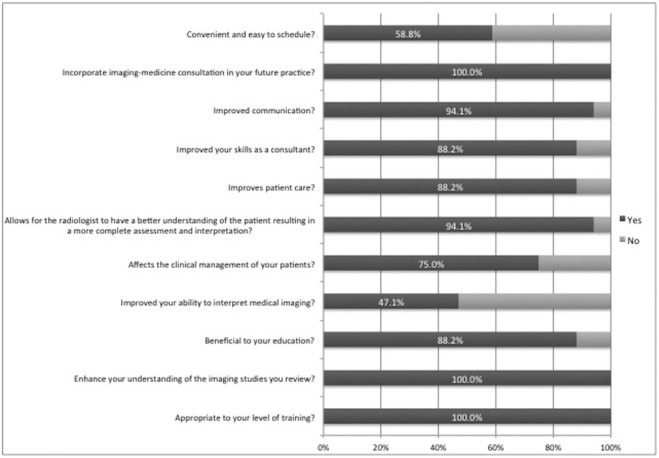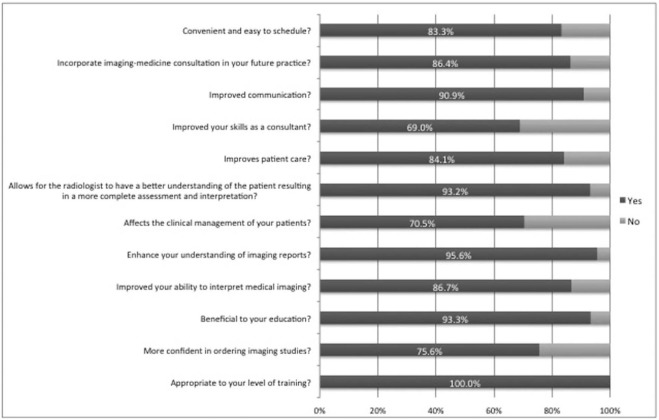Rationale and Objective
As health care moves toward bundled payment systems and merit-based incentive models, increasing awareness of the value of the radiologist is essential. A resident-driven clinical imaging rounds (CIR) program initiated at our institution allows radiologists to actively and directly participate in the team-based medical model. A retrospective review of survey data evaluated the qualitative and quantitative effects of CIR on clinical management, communication, and education of referring providers and radiology residents.
Materials and Methods
The initial 10 months of a resident-organized CIR were evaluated in a retrospective study. Twenty radiology residents and 150 internal medicine physicians and medical students participated in imaging rounds. An anonymous survey of participants was performed and results were analyzed.
Results
Eighty-five percent of radiology resident participants completed the survey ( N = 17). Approximately 30% of internal medicine participants completed the survey ( N = 45). There was an overwhelming positive review of imaging rounds, with a large majority of all groups agreeing that imaging rounds improve education, communication, and patient care.
Conclusions
Resident-driven imaging rounds provide a valuable opportunity to improve communication, education, and patient care. We have created a CIR with a sustainable workflow that allows direct and regularly scheduled imaging-medicine consultation valued by both radiologists and internal medicine physicians, improving the quality of patient care and providing education to our radiology residents in value-based care.
Background
Radiology consultation by referring physicians has traditionally been a part of standard clinical practice and reported as a preferred method of decision support for imaging . Before the widespread availability of picture archiving and communication system (PACS), traditional film rounds provided an opportunity for direct and iterative information exchange between the radiologist and the remainder of the care team, and served as a showcase for the expertise of the radiologist . Dedicated radiology consultation services have been implemented in the past . However, these have not become widespread likely as a result of the volume-based fee-for-service payment, which favors interpretations over consultative activities. As health care moves toward merit-based incentive models and alternative payment models, increased opportunities will arise for the radiologist to add value through improving quality and limiting costs. Awareness and documentation of contributions by radiologists are essential for radiologists to be recognized and compensated for the value they add .
The need for such a system has been emphasized by our professional organizations, which have developed campaigns to educate radiologists on the importance of value and quality of care in addition to quantity, as more and more focus is placed on the patient experience and referring physician satisfaction. Imaging 3.0, as defined by the American College of Radiology, is a “multiphase program consisting of services, technology tools and processes that enable radiologists to adapt how they manage their practices, patient care and their own futures.” Its purpose is to position radiologists as expert consultants to referring physicians and health systems, to support radiologists as diagnosticians and consultants, to empower patients and providers, and to align incentives, as payment incentives increasingly focus on value-based care . Based on the principles of Imaging 3.0, Action Case Studies have demonstrated the impact attending radiologists can make by providing accessible consultation services. “Case Study: Radiology’s Open Door” illustrates that traveling to the referring clinician work site to educate and listen to referring clinicians strengthens the visibility and credibility of radiologists as locally available consultants . “Case Study: The Value of Hard Work” demonstrated how quantifying radiologists’ contributions with a “Radiology Value-Added Matrix” resulted in a hospital-wide paradigm shift. Radiologists came to be considered “among the strongest physician leaders” within the hospital .
Get Radiology Tree app to read full this article<
Get Radiology Tree app to read full this article<
Get Radiology Tree app to read full this article<
Methods
Get Radiology Tree app to read full this article<
Get Radiology Tree app to read full this article<
Get Radiology Tree app to read full this article<
Get Radiology Tree app to read full this article<
Results
Get Radiology Tree app to read full this article<
Get Radiology Tree app to read full this article<
Get Radiology Tree app to read full this article<
Get Radiology Tree app to read full this article<
Get Radiology Tree app to read full this article<
Get Radiology Tree app to read full this article<
Get Radiology Tree app to read full this article<
Get Radiology Tree app to read full this article<
Get Radiology Tree app to read full this article<
Get Radiology Tree app to read full this article<
Get Radiology Tree app to read full this article<
Get Radiology Tree app to read full this article<
Discussion
Get Radiology Tree app to read full this article<
Get Radiology Tree app to read full this article<
Get Radiology Tree app to read full this article<
Get Radiology Tree app to read full this article<
Get Radiology Tree app to read full this article<
Get Radiology Tree app to read full this article<
Get Radiology Tree app to read full this article<
Appendix 1. Anonymous Electronic Survey Distributed to Radiology Residents Who Participated in the CIR
Get Radiology Tree app to read full this article<
Get Radiology Tree app to read full this article<
Get Radiology Tree app to read full this article<
Get Radiology Tree app to read full this article<
Get Radiology Tree app to read full this article<
Get Radiology Tree app to read full this article<
Get Radiology Tree app to read full this article<
Get Radiology Tree app to read full this article<
Get Radiology Tree app to read full this article<
Get Radiology Tree app to read full this article<
Get Radiology Tree app to read full this article<
Get Radiology Tree app to read full this article<
Get Radiology Tree app to read full this article<
Get Radiology Tree app to read full this article<
Get Radiology Tree app to read full this article<
Get Radiology Tree app to read full this article<
Get Radiology Tree app to read full this article<
Appendix 2. Anonymous Electronic Survey Distributed to CIR Participants Within the Internal Medicine Department
Get Radiology Tree app to read full this article<
Get Radiology Tree app to read full this article<
Get Radiology Tree app to read full this article<
Get Radiology Tree app to read full this article<
Get Radiology Tree app to read full this article<
Get Radiology Tree app to read full this article<
Get Radiology Tree app to read full this article<
Get Radiology Tree app to read full this article<
Get Radiology Tree app to read full this article<
Get Radiology Tree app to read full this article<
Get Radiology Tree app to read full this article<
Get Radiology Tree app to read full this article<
Get Radiology Tree app to read full this article<
Get Radiology Tree app to read full this article<
Get Radiology Tree app to read full this article<
Get Radiology Tree app to read full this article<
Get Radiology Tree app to read full this article<
Get Radiology Tree app to read full this article<
References
1. Bautista A.B., Burgos A., Nickel B.J., et. al.: Do clinicians use the American College of Radiology Appropriateness criteria in the management of their patients?. AJR Am J Roentgenol 2009; 192: pp. 1581-1585. Available at: http://www.ncbi.nlm.nih.gov/pubmed/19457821
2. Norbash A., Bluth E., Lee C.I., et. al.: Radiologist manpower considerations and imaging 3.0: effort planning for value-based imaging. J Am Coll Radiol 2014; 11: pp. 953-958.
3. Khorasani R., Silverman S.G., Meyer J.E., et. al.: Design and implementation of a new radiology consultation service in a teaching hospital. AJR Am J Roentgenol 1994; 163: pp. 457-459.
4. Moser J.W., Wilcox P.A., Bjork S.S., et. al.: Pay for performance in radiology: ACR white paper. J Am Coll Radiol 2006; 3: pp. 650-664.
5. American College of Radiology : Imaging 3.0 FAQ. Available at: http://www.acr.org/FAQs/imaging-3-faq Accessed July 16, 2016
6. Hassan A.: Case study: radiology’s open door. 1–3; Available at: http://www.acr.org/~/media/ACR/Documents/PDF/Economics/Imaging3/CaseStudies/2015/QualityAndSafety/RadiologysOpenDoor/Imaging3_RadioloysOpenDoor_May2015_final.pdf
7. Hobson C.: Case study: the value of hard work. 1–2; Available at: http://www.acr.org/~/media/ACR/Documents/PDF/Economics/Imaging3/CaseStudies/Imaging3_TheValueofHardWork_August2014.pdf
8. RSNA : Radiology cares. Available at: http://www.rsna.org/radiology-cares/ Accessed July 12, 2016
9. Mangano M.D., Bennett S.E., Gunn A.J., et. al.: Creating a patient-centered radiology practice through the establishment of a diagnostic radiology consultation clinic. AJR Am J Roentgenol 2015; 205: pp. 95-99.
10. Slanetz P.J., Mullins M.E.: Radiology education in the era of population-based medicine in the United States. Acad Radiol 2016; 23: pp. 894-897. Available at: http://www.sciencedirect.com/science/article/pii/S1076633216001227
11. Cizman Z., Hammer M., Mollard B., et. al.: A resident perspective on adding value as radiologists. Acad Radiol 2016; 23: pp. 517-520. Available at: http://dx.doi.org/10.1016/j.acra.2015.12.006
12. ACGME : ACGME program requirements for graduate medical education in diagnostic radiology. Available at: https://www.acgme.org/Portals/0/PFAssets/ProgramRequirements/420_diagnostic_radiology_2016.pdf
13. Porter M.E.: What is value in health care?. N Engl J Med 2010; 363: pp. 2477-2481. Available at: http://www.ncbi.nlm.nih.gov/pubmed/21142528

